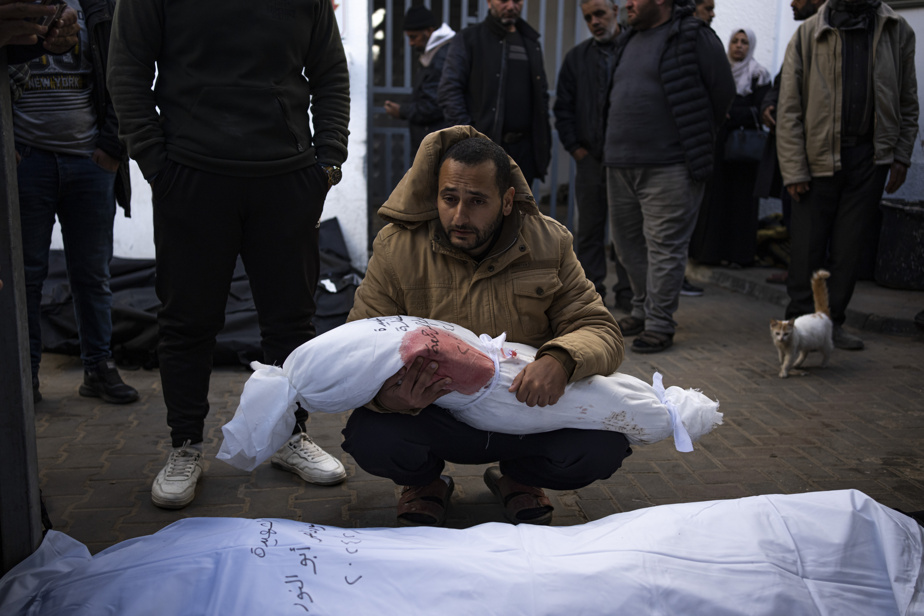In the Gaza Strip, which has been bombed for more than ten months and largely turned into a field of ruins, counting the dead is a daily challenge. How does the Hamas government’s Health Ministry go about establishing its toll, now at more than 40,000 dead?
The remains are identified either by the elements found on them or by a relative, noted AFP journalists who have visited several hospitals in the Palestinian territory, where a war is pitting Israel against the Islamist movement Hamas.
The personal information of the deceased is then entered into a computerized database of the Palestinian Ministry of Health in the Gaza Strip, which lists the name, gender, date of birth and identity card number of the deceased.
When bodies are unidentified – whether they are unrecognizable or no one comes to claim them, with entire families sometimes killed in a strike – caregivers record them with a number and as much information as they can gather.
Jewelry, watches, telephones, birthmarks: every clue is collected and photographed. Two AFP correspondents witnessed how health establishments inform the ministry’s system.
“Central register”
In several statements, the Gaza Health Ministry also explained the procedure followed to compile the report.
For so-called “government” hospitals, which fall under the Hamas administration ruling Gaza, the “personal information and identity number” of each Palestinian killed during the war are entered into the facility’s computerized database after the body arrives or after their death for the wounded who succumb, according to the ministry.
This data is then transmitted “daily” to the ministry’s “central register of martyrs”.
As for the dead evacuated to private hospitals, their personal information is recorded on a form which is then sent “within 24” hours to the ministry to be integrated into the central database.

PHOTO HUSSAM AL-MASRI, REUTERS ARCHIVES
At Nasser Hospital in Khan Younis
The “information center”, a dedicated department of the ministry, is responsible for checking the information provided by “government” and private hospitals to “ensure that it does not contain duplicates or errors”, before registering the names in the database.
Gazans are also invited by the Palestinian authorities to report the loss of a loved one on a website of the Ministry of Health, which uses this data for its verifications.
The ministry is staffed by officials from both the Palestinian Authority, which is based in Ramallah, and Hamas, the rival movement that seized power in the Gaza Strip in 2007.
“Strong correlation”
An investigation by the NGO Airwars, which specialises in the impact of wars on civilians, analysing nearly 3,000 names of people killed, established “a strong correlation between official data […] and what Palestinian civilians reported online – 75% of publicly reported names also appearing on the Health Ministry list.”
The study notes, however, that as the war progressed, the ministry’s statistics “became less accurate,” saying that damage to the health system had made the task more difficult.
For example, of the 400 computers in Nasser Hospital, one of the last health facilities operating partially in the southern Gaza Strip, only 50 are working, the director, Atef Al-Hout, told AFP.
While the Israeli authorities regularly question Hamas’ statistics, which do not detail the number of civilians and combatants killed, suspecting them of being manipulated, the army and the prime minister do not contest the order of magnitude of the overall toll.
In Gaza, the Hamas government’s press services estimate that nearly 70% of the dead, whose number was established on Thursday at 40,005 people, are women (around 11,000) and “children” (at least 16,300).
In Israel, the unprecedented attack by Hamas on October 7, which triggered the war in Gaza, resulted in the deaths of 1,198 people, mostly civilians, according to an AFP count based on official Israeli data.
Sometimes controversial
The daily reports published by Hamas’s health ministry have sometimes been disputed, notably by US President Joe Biden, who questioned their credibility at the start of the conflict.
But last March, he spoke of “thousands and thousands” of civilians killed, without commenting further on the veracity of the ministry’s statistics, which also lists the wounded.
The figures are cited by most international organisations, and several UN agencies, including the one responsible for Palestinian refugees (UNRWA), have considered the statistics to be credible.
“In the past, the statistics of the five or six cycles of conflict in the Gaza Strip were considered credible. No one has ever really contested these data,” declared the director of UNRWA, Philippe Lazzarini, in Jerusalem at the end of October.
In a letter published in July on the website of the British medical journal The Lancet, a group of researchers estimated that in the long term, based on a statistical projection based on figures from the Gaza Ministry of Health, the total death toll from the war could rise to 186,000 or more, a figure that would then include not only those killed directly by the fighting but also deaths linked to the consequences of the hostilities, such as the health and humanitarian crisis.
